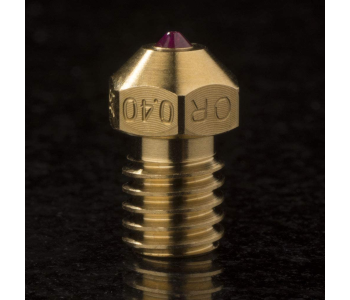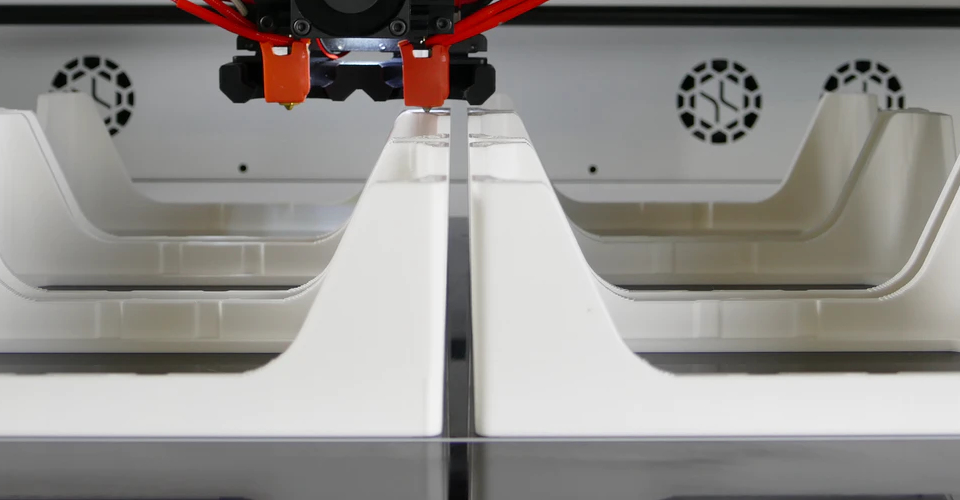Binder Jetting Technology in 3D Printing – Everything You Need to Know
A lot of people are now familiar with 3D printing but only in the form of a moving print head extruding molten filament. This is great for a hobby or small-scale business. However, there is also an industrial version of 3D printing that works with materials that are a bit more robust than plastic,
Binder jetting is one of the more common methods of 3D printing for applications that require materials such as metals or ceramics. It is recognized as one of the more industrially relevant additive manufacturing techniques, especially for high-volume production. What exactly is binder jetting and how does the technology work?
What is binder jetting?

Binder jetting is another production method classified under additive manufacturing or 3D printing. As such, the process starts with a 3D model that is processed by a slicer and converted to a corresponding CNC program.
What sets binder jetting apart is the fact that it uses raw material in powdered form. This powder is usually made of metals or ceramics, although polymer-based powders have been becoming more common lately. To create large solids from these powders, they are treated with a binding agent ejected from print heads.
Another unique characteristic of binder jetting is that it is a 3D printing method that does not use heat during the build process. This gives binder jetting a wider selection of usable materials, as well as eliminated any thermal stress from the finished products.
Binder jetting provides the same set of advantages of 3D printing as an additive manufacturing method. It can be used to recreate any digital model and is capable of reproducing highly complex designs with inner channel and internal features. This has proven revolutionary in the metal fabrication industry, as it has allowed them to overcome the limitations of traditional manufacturing methods like casting and forging.
For these reasons, many companies consider binder jetting as the 3D printing technique that can most appropriately provide an alternative to traditional high-volume manufacturing. Over the last few years, great leaps have been made in this technology as more industries acknowledge the benefits of binder jetting,
How does binder jetting work?
As with any 3D printing process, binder jetting starts with a digital 3D model. The model is divided into very thin slices that become the basis for writing the G-Code or CNC program. Through this process, the entire binder jetting process can be almost completely automated.
On the physical side of things, the raw powder is deposited on a moving build plate. After one layer has been finished, the build plate moves down to accommodate a fresh coat of powder as applied by a roller. The unprocessed raw powder remains in the build plate, providing mechanical support to the print.
The binding agent that forms the layer is delivered by an array of very small nozzles. This uses the same mechanism as the print heads in your standard inkjet printers except that the nozzles are very fine. Droplets of the binding agent are deposited strategically on the raw powder and diffuse almost instantly into the empty spaces between the solid particles.
After printing, the finished project is considered to still be in a ‘green’ state. Although the print should be fairly solid at this point, it still has not attained its optimal mechanical properties. For this to happen, it has to be cured by placing it inside an oven at about 200 C for several hours.
Objects made via binder jetting tend to come out with a large volume of void spaces. These voids are very small but can compromise the mechanical integrity of the finished print. If the object needs to be used for heavy-duty applications, it often needs to be enhanced by the “infiltration” of liquid metal into its void spaces. Bronze is the most common metal used for infiltration.
Pros and cons of binder jetting
The transition of many manufacturing companies to binder jetting seems to indicate that its benefits outweigh its drawbacks. However, as with most novel technologies, binder jetting is not a perfect replacement for more traditional methods.
PROS
Suitable for batch production

Industrial binder jetting 3D printers can have arrays of print heads with a huge number of nozzles. These nozzles can work independently and deliver a binding agent to different spots in the build platform.
This makes binder jetting a suitable method for batch reproduction of small parts. Within the same run, several copies of the same model can be 3D printed. This unique benefit has made binder jetting the 3D printing technology of choice for high-volume manufacturing,
High-resolution 3D printing
The specifications may vary from one 3D printer to another, but binder jetting typically delivers very high resolution. A typical binder jetting printer can produce as many as 600 million drops of binding agent each second. This is equivalent to about 1200 dpi resolution. This level of precision makes it possible to create very fine features and smooth surfaces in prints made via binder jetting.
No need for supports
The use of a powdered raw material provides a unique benefit to binder jetting. Since the unprocessed powder remains in the build platform, it provides mechanical support to the print as the project proceeds. This means that binder jetting prints no longer need to have support structures. The self-supporting characteristic provides a greater degree of design freedom, even more so than filament or resin-based 3D printing methods.
Tool-free manufacturing
This is more of a byproduct of the two previous benefits we have listed above. Since binder jetting prints already come out with perfectly smooth surfaces, there is no longer any need for post-printing smoothing. Removal of support structures is also no longer needed.
The lack of any tool-based post-processing requirement for binder jetting gives projects a much shorter turnaround time. The manufacturing industry refers to binder jetting as a ‘tool-free method.’ The simplified workflow reduces production times, lessens handling of green products, and helps to avoid damage to finished products due to tool-based post-processing.
Cheaper than laser-based 3D printing
In terms of resolution and overall quality, binder jetting is comparable to laser-based 3D printing methods like Selective Laser Sintering (SLS) and Direct Metal Laser Sintering (DMLS). These other methods are good comparison points because they also allow for the 3D printing of metallic materials.
The advantage of binder jetting is that it’s cheaper than DMLS and SLS on account of not having a high-power laser in its assembly. The nozzles that deliver the binding agent may be very fine, but the technology behind them is almost the same ones we have in our desktop printers.
CONS
High capital costs

Binder jetting is a 3D printing technology that is gated by huge capital costs. For this reason, binder jetting 3D printers are rarely found outside of industrial or research facilities. Small businesses, schools, and hobbyists will likely have to settle with filament-based or resin-based 3D printing methods.
Mechanically inferior
Compared to traditional metalworking methods, binder jetting simply cannot compare in terms of overall strength and durability. This statement even holds true in comparison to laser-based 3D printing technologies such as SLS or DMLS. This severely limits the possibilities of what can be manufactured using binder jetting and makes it a less than perfect replacement to metal manufacturing methods such as casting and forging.
Applications of binder jetting
Despite the few drawbacks of binder jetting, the technology remains relevant enough for large companies to invest in. One of the more notable efforts in this field is the Metal Jet 3D printing system developed by HP. With their experience in designing inkjets, HP was able to introduce innovations that have reduced the binder composition of finished prints from 10% to only about 1%. This has the potential to create much stronger metal prints after sintering.
Metal-based binder jetting is used for inexpensive batch production of geometrically complex pieces. Examples include spare parts for industrial equipment, jewelry, and interior design pieces.
Creating molds with sand powder has also proven to be one of the more industrially important applications of binder jetting. Although full-color sand models make great standalone products, sand is more commonly used to make durable and heat-resistant molds. Making sand molds using binder jetting is cheaper and generally faster than the usual methods used in casting.
Final thoughts
As the additive manufacturing industry makes the transition to Industry 2.0, new technologies like binder jetting have starter to take more profound roles. Binder jetting provides a compelling alternative to traditional metalworking methods. It is more easily automated and is capable of reproducing highly complex geometries. Binder jetting equipment also has a smaller footprint.
This does not mean that binder jetting will completely replace molding, casting, or forging. Right now, objects made from binder jetting are still too mechanically weak to compete with more old-fashioned metalworks. Efforts are underway to improve binder jetting technology with big names like HP joining the fray. With growing interest, we may yet see binder jetting fulfill its unrealized potential.


